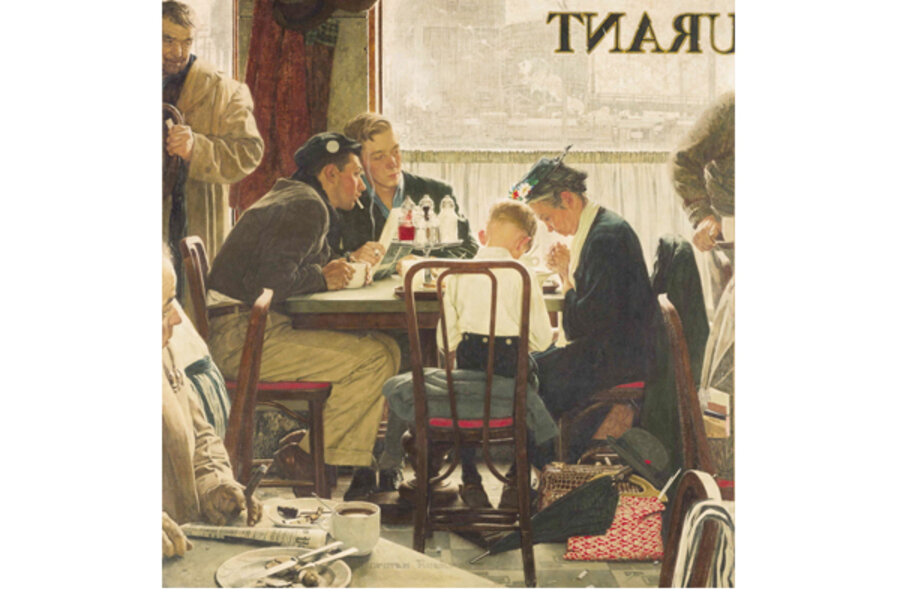Norman Rockwell family calls Deborah Solomon's Rockwell bio 'fiction'
Loading...
His paintings depict such a warm American utopia replete with sweet small-town scenes, tender moments, and flawless family vignettes that Norman Rockwell illustrations have become something of a paragon of perfect domestic happiness.
But the man behind those blissful scenes lived a far darker life, fraught with anxiety, depression, and loneliness. He was a twice-divorced, thrice-married repressed homosexual who gravitated toward men and boys.
So says Deborah Solomon, author of a new – and very controversial – biography of the famous family man, “American Mirror: The Life and Art of Norman Rockwell.”
The allegations in Solomon’s daring new book have been drawing intense speculation about the man Americans thought they knew. After all, who can resist dark revelations about an icon of American idealism?
They are also drawing objection from Rockwell’s family, who cooperated with Solomon on the book and are calling her claims “false” and “unsubstantiated.”
First, the facts: Rockwell did, indeed, marry three times and father three sons. His first wife left Rockwell for another man, his second suffered from depression and died at age 51, possibly by suicide.
Unlike the paradigm of familial bliss he depicted in his paintings, Rockwell’s relationships with his family members, including his mother, wives, and sons, appeared to have been fraught with difficulty.
Solomon says Rockwell was married to his work at the expense of his family.
He was also a hypochondriac (hence the frequent image of doctors in his art, says Solomon) who later formed a close friendship with his psychiatrist, the famous Freud follower Erik Erikson.
He was an obsessive-compulsive neat freak who rinsed his paintbrushes multiple times a day, washed his paintings with Ivory soap, and scrubbed his studio floors.
The assertions: Solomon says Rockwell “prefer[ed] male company,” and that “it’s possible to discern enormous homoeroticism as well as a desire to distance himself from his own desires.”
She recounted an episode in which Rockwell went camping in the Adirondacks and shared a bed with his assistant Fred Hildebrandt. The next morning he wrote in his journal, “Fred looked fetching in his pajamas.”
“He was very comfortable around men and he loved male bodies,” Solomon told the Wall Street Journal in an interview, in which she adds that there is no evidence Rockwell actually had physical relationships with men or boys.
Solomon notes that of 322 covers for the Saturday Evening Post, only three of Rockwell’s illustrations depict a traditional portrait of family of parents and at least two children. The majority, she says, feature men and boys.
As the New York Times notes, she points to homoerotic undertones in paintings like “Sailor Dreaming of a Girlfriend,” “Before the Shot,” and “The Runaway,” which depict two sailors seated close together with one gazing at the other, the bare bottom of a young boy at a doctor’s office, and a beefy policeman seated beside a young boy at a diner counter, respectively.
Solomon told the WSJ that sexual repression fueled Rockwell’s art. “Repression does wonders for your art,” she said. “I think a canvas doesn't lie, and I think art does not lie, and whatever was on the canvas was the true Rockwell.”
Solomon also speculates that Rockwell contemplated suicide and threatened to kill himself on at least one occasion.
Still, there are doubts about Solomon’s assertions.
As USA Today points out, this isn’t the first time a “famous dead person” has “retrospectively [been] labeled gay by modern gender theorists.”
Rockwell’s family, which cooperated with Solomon on the book, says her assertions are largely false.
“Ms. Solomon's book does not give a scholarly or factual account of Norman Rockwell's life and work,” the Norman Rockwell Family Agency said in a statement. “Rather she concocts a fictionalized life. In doing so, she attempts to falsify all that the Family and the world know about him. In unfounded claims of homosexuality, Ms. Solomon obsessively attempts to demonstrate her 'logical' evolution to pedophilia with not a shred of evidence apart from her unsupportable conjectures. She consistently pretends to know how Norman Rockwell 'felt' and what 'impulses' he harbored when there is no basis for such speculation, in her book or elsewhere.”
It continued, “The Rockwell Family fully cooperated with Ms. Solomon with complete transparency and trust in her quest to create the authoritative work on Norman Rockwell. Chronologically and factually, she seriously misinterprets, omits important material, makes many factual errors, and fictionalizes incidents…. The Family now feels that her purpose in befriending us and writing this fictionalized account was publicity, financial gain and self-aggrandizement.”
The Rockwell are certainly not the first family to be dismayed by a biographic portrayal of their loved one. In fact the Rockwell story is somewhat reminiscent of the controversy over "Schulz and Peanuts," David Michaelis's 2007 biography of cartoonist Charles Schulz. The Schulz's children initially cooperated with Michaelis – offering Michaelis access to private papers, as did the Rockwell family with Sololmon – but were ultimately dismayed by his portrait of their father as depressed, melancholic, and a cold and absent parent.
In the case of Rockwell, it's hard to argue with Solomon's statement that "whatever was on the canvas was the true Rockwell." But it's also true that the artist himself is the only one truly equipped to give us an accurate read of his own art. All the rest of us – skilled biographers and loved family members alike – can never really do better than guess.
Husna Haq is a Monitor correspondent.





